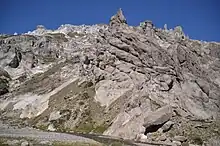Puelche language
Puelche was a language formerly spoken by the Puelche people in the Pampas region of Argentina. The language is also known as Gününa Küne, Gennaken (Guenaken), Northern Tehuelche, Gününa Yajich, Ranquelche, and Pampa.
| Puelche | |
|---|---|
| Gennaken | |
| Gününa Küne | |
| Native to | Argentina |
| Region | Río Negro |
| Ethnicity | Puelches |
| Extinct | 1934[1] with the death of Trruúlmani |
| Language codes | |
| ISO 639-3 | pue |
| Glottolog | puel1244 |
| ELP | Gününa-Küne |
Classification
Puelche has long been considered a language isolate. Based on very limited evidence, Viegas Barros (1992) suggests that Puelche might be closely related to the language of the Querandí, one of the Het peoples, and Viegas Barros (2005) that it is related to the Chon languages.[2] Further afield, inclusion in a putative Macro-Jibaro family has been posited.

Documentation
In 1829, D'Orbigny toured the area of southern Buenos Aires and the mouth of the Río Negro. There he collected words of the “puelches”, “aucas” and “tehuelches” —that is, in günün a iajüch, mapuzungun and teushen, respectively—in the vicinity of Carmen de Patagones, in a permanent settlement of linguistically heterogeneous groups.
The French traveler, intrigued by the indigenous languages of the area, arrived at the tolderías and contacted some interpreters:
"In a tent of friendly Patagonians I found a woman named Lunareja who spoke enough Spanish as if to serve as an interpreter; belonged to the Puelche nation and was married to a Patagonian, so that I knew both languages equally, which was of the greatest use to me. I also knew Araucanian, but the notions of this language could be better transmitted to me by the Indians."
In L'Homme américain (de l'Amérique méridionale) he includes some comments on which highlights pronunciation features, the use of the morpheme ya- prefixed to the parts of the body, the numbering system or the absence of gender markings on adjectives, as well as a list of words that compares with those of
Phonology
Vowels
| Front | Back | ||
|---|---|---|---|
| Unrounded | Unrounded | Rounded | |
| Close | i | ɯ | u |
| Close-mid | e | ɤ | o |
| Open-mid | ʌ | ||
| Open | a | ||
A short sounding /e/ is realized as [ɛ].
Consonants
Puelche has 25 consonants:[5][6]
| Bilabial | Alveolar | Retroflex | Palatal | Velar | Uvular | Glottal | ||
|---|---|---|---|---|---|---|---|---|
| Nasal | m | n | ||||||
| Plosive | voiceless | p | t | k | q | ʔ | ||
| ejective | pʼ | tʼ | kʼ | (qʼ) | ||||
| voiced | b | d | ɡ | |||||
| Affricate | voiceless | t͡s | t͡ʂ | t͡ʃ | ||||
| ejective | t͡sʼ | t͡ʂʼ | t͡ʃʼ | |||||
| Fricative | s | ʂ | ʃ | x | h | |||
| Lateral | voiceless | ɬ | ||||||
| voiced | l | ʎ | ||||||
| Rhotic | trill | r | ||||||
| tap | ɾ | |||||||
| Semivowel | j | w | ||||||
It is not clear if there is a uvular ejective stop [qʼ].
Vocabulary
Loukotka (1968) lists the following basic vocabulary items for Gennaken.[7]
gloss Gennaken one chéye two päch ear chütsk tooth xaye hand yapal foot yapgit sun apiúkük moon apioxok dog dáshü
Comparative Vocabulary
- Below there is a list of comparative vocabulary between Chonan languages; Puelche, Teushen, Selk'nam, Tehuelche, and Haush, as well as Moseten languages; Chimane and Mosetén.[7][8][4]
| Chon | Mosetén | ||||||
|---|---|---|---|---|---|---|---|
| English | Puelche | Teushen | Ona | Tehuelche | Haush | Chimane | Mosetén |
| one | chéye | cheuquen | sôs | chochieg | setaul | irit | irit |
| two | päch | xeukay | sôki | h'áuke | aim | pana | pára |
| three | gütʳsh | keash | sauke | ká'ash | shaucn | chibin | chibin |
| four | málǖ, mālǖ | kekaguy | koni-sôki | kague | tsis | ||
| five | tān’kǖ, tan’kü | keytzum | kismarei | k'tsáen | cánam | ||
| six | thrüman, tshüman | wenecash | kari-koni-soki | uaenecash | ebeuñ | ||
| seven | katʳshpetsh; katrshpitsh | kuka | kari-kísmarei | aiéké | yevetige | ||
| eight | pūúsha | wenekekague | karikei-konisoki | venik'cage | quencañ | ||
| nine | tsheyiba, tshiība | kekaxetzum | kauken-kísmarei | yamakeitzen | arajatec | ||
| ten | ts’amátskǚ | xaken | karai-kísmarei | kaken | tac | ||
Bibliography
- Casamiquela, Rodolfo M. (1983). Nociones de gramática del gününa küne. Paris: French National Centre for Scientific Research.
- Adelaar, Willem (2004). The Languages of the Andes. Cambridge University Press. ISBN 978-0-521-36275-7.
See also
References
- Puelche at Ethnologue (18th ed., 2015) (subscription required)
- Campbell, Lyle (2012). "Classification of the indigenous languages of South America". In Grondona, Verónica; Campbell, Lyle (eds.). The Indigenous Languages of South America. The World of Linguistics. Vol. 2. Berlin: De Gruyter Mouton. pp. 59–166. ISBN 9783110255133.
- d'Orbigny., Alcide Dessalines (1923). L'Homme américain (de l'Amérique méridionale) (in French).
- Lehmann-Nitsche, Roberto. "Vocabulario Puelche" (PDF).
- Casamiquela, Rodolfo M. (1983). Nociones de gramática del gününa küne. Paris: French National Centre for Scientific Research. pp. 34–40.
- Barros, J. Viegas. Un nuevo análisis fonológico del gününa yajüch. CONICET-Universidad de Buenos Aires
- Loukotka, Čestmír (1968). Classification of South American Indian languages. Los Angeles: UCLA Latin American Center.
- "South Amerindian Languages". zompist.com. Retrieved 2023-05-09.
External links
- Gününa Küne language dictionary online from IDS (select simple or advanced browsing)
- WALS: Puelche
- Gününa Küne (Intercontinental Dictionary Series)